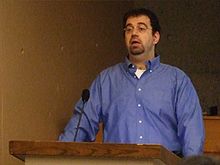Daron Acemoğlu
Daron Acemoğlu (born September 3, 1967 in Istanbul ) is a Turkish - American economist of Armenian descent. His father Kevork, who died in 1988, was a lawyer and lecturer at Istanbul University. His mother Irma († 1991) was an Armenian poet and school teacher.
academic career
Acemoğlu is the Elizabeth & James Killian Professor of Applied Economics and Institute Professor at the Massachusetts Institute of Technology . He also works at the National Bureau of Economic Research and the Center for Economic Policy Research . Acemoglu received his bachelor's degree from York University in 1989 and his PhD in 1992 from the London School of Economics and Political Science . He was awarded the John Bates Clark Medal in 2005 , the Nemmers Prize for Economics in 2012 and the BBVA Foundation Frontiers of Knowledge Award in 2016 . For 2019 he won the World Economic Prize . From 2011 to 2015 Acemoglu was editor of the trade journal Econometrica . In 2006 he was elected to the American Academy of Arts and Sciences , as well as to the National Academy of Sciences in 2014 .
research
As a researcher, he is particularly active in the fields of political economy , development economics , growth theory, technology, income and wage inequality, human capital and training, and labor economics.
His essay Reversal of Fortune: Geography and Institutions in the Making of the Modern World Income Distribution , co-published with Simon Johnson and James A. Robinson in 2001, sparked a debate between Acemoglu and Jeffrey Sachs about the causes of underdevelopment. In contrast to Sachs, who attributes underdevelopment primarily to geographical factors, Acemoglu et al. the view that poor institutional frameworks are the main reason for the differences in the level of economic development between different former colonies. According to their investigation, the colonizers created institutions for investments in the poorer regions (e.g. Australia) (broader property rights for the population), while in the more affluent regions (e.g. the former areas of the Incas in South America), e.g. . B. Forced labor was used and power was in the hands of a small elite (so-called extraction institutions). As a result, the relationship between poorer and wealthier colonies was reversed from the 19th century onwards.
This approach was u. a. criticized by Pranab Bardhan as being too Eurocentric , since he is unable to explain the economic underdevelopment of non-colonized or little-colonized states such as Ethiopia , Thailand or China .
Fonts
- with Simon Johnson and James A. Robinson: The colonial origins of comparative development . 2001.
- with James A. Robinson: Economic Origins of Dictatorship and Democracy. 2005.
- Introduction to Modern Economic Growth. 2008.
- with James A. Robinson: Why Nations Fail: The Origins of Power, Prosperity, and Poverty. 2012. In German: Why Nations Fail : The Origins of Power, Prosperity and Poverty , translated by Bernd Rullkötter, S. Fischer, Frankfurt am Main 2013, ISBN 978-3-10-000546-5 . ( Nations and their prosperity: Keys to wealth , review by Christian Rickens in Spiegel Online , April 7, 2012.)
- with James A. Robinson: The Narrow Corridor. State, Societies, and the Fate of Liberty , Penguin, New York 2019. In German: Balance of Power. The eternal struggle between state and society , from the English by Bernhard Jendricke et al., S. Fischer Verlag, Frankfurt am Main 2019, ISBN 978-3-10-397336-5 .
Web links
- Website of Daron Acemoglu at MIT with curriculum vitae and list of publications
- Robert Gavin at the Boston Globe on the occasion of the award of the John Bates Clark Medal .
- iconomix: How important good institutions are. Retrieved March 1, 2013 (German, Daron Acemoğlu explains why good institutions decide between rich and poor).
- Tina Kaiser and Tobias Kaiser: Daron Acemoglu. Why is this economist worth a million dollars? In: Welt Online , March 31, 2014 (see also in: Welt am Sonntag 13, March 30, 2014, page 8.)
- Daron Acemoğlu in the catalog of the ZBW - Leibniz Information Center for Economics (ZBW)
Footnotes
- ↑ http://economics.mit.edu/faculty/acemoglu/cv
- ^ Robert Gavin: MIT professor named top economist under 40 . In: Boston Globe . June 15, 2005. Retrieved July 4, 2014.
- ^ Daron Acemoglu named Institute Professor. Retrieved December 12, 2019 .
- ^ Past Editors and Co-editors of Econometrica | The Econometric Society. Retrieved June 7, 2020 .
- ^ National Academy of Sciences Members and Foreign Associates Elected. ( Memento of the original from August 18, 2015 in the Internet Archive ) Info: The archive link was inserted automatically and has not yet been checked. Please check the original and archive link according to the instructions and then remove this notice. Press release from the National Academy of Sciences (nasonline.org) dated April 29, 2014
- ^ NBER Working Papers. 8460, 2001; published as: Daron Acemoglu, Simon Johnson & James A. Robinson: Reversal Of Fortune: Geography And Institutions In The Making Of The Modern World Income Distribution. In: Quarterly Journal of Economics. v107, November 4, 2002, pp. 1231-1294.
- ↑ Pranab Bardhan (2005), Scarcity, Conflicts and Cooperation: Essays in Political and Institutional Economics of Development ( Memento of the original from October 9, 2012 in the Internet Archive ) Info: The archive link was inserted automatically and has not yet been checked. Please check the original and archive link according to the instructions and then remove this notice. , MIT Press , p. 4.
| personal data | |
|---|---|
| SURNAME | Acemoğlu, Daron |
| BRIEF DESCRIPTION | American economist |
| DATE OF BIRTH | 3rd September 1967 |
| PLACE OF BIRTH | Istanbul , Turkey |
